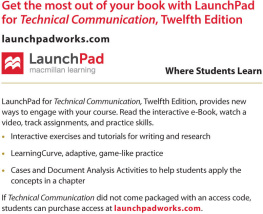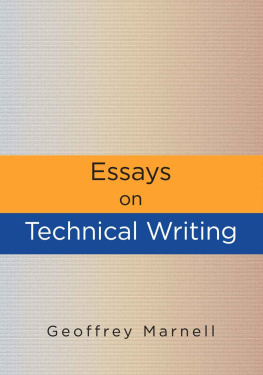| The Language |
| of Technical |
| Communication |
| Ray Gallon |
This book is dedicated to the memory of Ellen Stewart,whose prophecy took thirty years to come true.If she were here, shed be rocking back and forthin rhythm to her broom, sweeping the floor of her theatre,smiling an eldritch smile, and saying, I told you so.
eBook Introduction
Thank you for purchasing The Language of Technical Communication.I hope you enjoy the book and find it useful.
Best Regards,
Ray Gallon
May 2016
Foreword
The field of technical communication has been around as long as people have used processes, procedures, products, and services. But recently, the field has been evolving more and more quickly, as new technologies and new ways to reach our audiences have become available.
I recently said to my wife, I linked our Nest with Alexa. I didnt need to explain that I had linked our has become ubiquitous in our daily lives.
We are continually reminded of the power of devices that sense and interpret context. My phone knows where I am. It knows when Im leaving work to drive home and reports my expected commute time. It knows what sports teams I follow and what companies I like, and it knows when Im traveling.
These technologies grant amazing new capabilities for understanding and reaching our audiences. The best customer experiences occur when documentation anticipates needs, context, and goals, and these technologies, many of which are discussed in this book, make it easier for us to create those kinds of customer experiences.
The terms defined in this book range from basic terminology that most of us know to the latest concepts pushing the boundaries of the discipline. Do you need a refresher in basic and invariant technical communication concepts? Consider the Core Concepts section. Want to dive deeper? The Technical Concepts section will ground you in approaches for creating, managing, and delivering your content using proven processes.
The Standards and Conventions section will bring you up-to-date on the latest standards-based approaches, which will help you manage your content more effectively, especially in the face of changing tools and technologies.
Would skills?
How are you and your organization responding to changes in the outside world? Take a look at the Future Directions section, where you can read about topics such as .
How do you deliver content? The Deliverable Presentations section may provide new ideas for serving an increasingly mobile audience that expects information on demand, in the appropriate form, targeted for their situation, and available on any device. This audience also expects information to be more interactive, to actively respond to context, and, as always, to address their needs in the most concise, direct manner possible.
As technical communicators, we seek a user-centered approach that provides the right information, in the right way, at the right time to make someones life easier and more productive. Part of our tool kit for implementing a user-centered approach is the vocabulary we use with our colleagues.
If we have a common understanding of the language of technical communication, we can be more effective and efficient in our interactions with our colleagues. Whether you are a newly hired trainee or a seasoned professional, understanding the body of terms in this book will make it easier to work together.
While our methods and techniques may be changing, the mission of technical communication remains unchanged: explaining processes, procedures, products, and services. And helping make people successful. This book can help you be more effective in carrying out that mission.
Alan Houser
Group Wellesley, Inc.
Consultant and Trainer, Technical Publishing
http://groupwellesley.com
Preface
As I sat down to write this preface, I had an epiphany: here we have a book of technical communication terminology, and yet the term technical communication is nowhere defined in it! Then I had a second thought: isnt that so like us? Ive been in this profession for over 20 years, and I still have family who ask, So, Ive never been able to figure out exactly what you do, can you explain it?
During my tenure on the board of directors of the Society for Technical Communication (STC) we made a decision to stop trying to define the profession and refer to technical communication as a discipline . I think this is the right course. So herewith, I present to you, dear readers, a selected list of terms pertinent to the discipline that we all practice, but that I am not going to define Ill leave it to you to answer your own families curiosity in your own way.
This book is an example of the joy and the terror of being a technical communicator. We are a varied, multi-talented lot, and we do a huge variety of things, many of which are not in our job descriptions. This means that any list of terms will necessarily contain some exotic notions, and leave out some terms that might be considered essential. Our choices were dictated by two overarching admonitions: that the list not be limited to technical writing , but include all aspects of technical communication; and that the list continue to be valid and applicable into the foreseeable future. Following these prescriptions was challenging and produced at least one editorial crisis, just when we thought we had it all figured out. I believe this book is the better for it.
We are an international team. To start with, Richard and I successfully collaborated, using the nine-hour time difference between California and Europe to keep some tasks going round the clock. The contributors also come from both sides of the Atlantic, and represent practitioners in a variety of roles and industries, from different linguistic and cultural backgrounds, an illustration of just how global our discipline is.
This book is also an example of how we practice what we preach. We wrote the terms in a wiki built on a specialized DITA schema, and we practice reuse. Those of you who have read The Language of Content Strategy , another book in this series, will recognize certain terms: content, accessibility, findability, metadata, single sourcing, structured content, content reuse, transclusion, intelligent content, augmented reality, governance model, localization, globalization, and terminology management were all found there. In some cases, they are reused as is, and in others, they have been modified to be more directly applicable to technical communication. In one case, the technology is changing so fast that we wrote a whole new definition. There is so much overlap between content strategy and technical communication that we have also provided an appendix in the form of a glossary, which contains more content strategy terms that we think are essential for a technical communicator.
The job of editor of a collective work is made vastly more enjoyable and dare I say it easier when there are first-class contributors. And here, I have to say that we have been more than fortunate. Most of the credit for any success this book may have goes to the 52 experts who authored terms, with sincere gratitude for their skill, their willingness to rewrite and be edited, and the quality of their work.
Having Richard Hamilton as a sidekick has also made this book a joyful process, in both his roles as fellow editor and as publisher. Don Day worked tirelessly, sometimes day and night, to get our wiki up and running, and his openness to our suggestions and his willingness to roll with the punches has also facilitated the cause enormously. And special thanks to Scott Abel, The Content Wrangler, for the opportunity to create this book and for precipitating the editorial crisis that has made it so much better.









